Art Lovers discussion
Art Lovers News Corner
>
June 2010
 So sad. I was able to see some of the Bourgeois spiders in Philadelphia and Washington, DC. The show in DC was great and had many of her pieces and a video of her life. The "Arch of Hysteria" was there as well. I believe I remember that her mother repaired fine tapestries, and the spiders she did were a representation of her mother the weaver.
So sad. I was able to see some of the Bourgeois spiders in Philadelphia and Washington, DC. The show in DC was great and had many of her pieces and a video of her life. The "Arch of Hysteria" was there as well. I believe I remember that her mother repaired fine tapestries, and the spiders she did were a representation of her mother the weaver.
 She was a remarkable artist and continued to get better as she got older. It's very sad news that she's gone, but she lived a long and productive life, and it's nice that she eventually got the recognition she deserved.
She was a remarkable artist and continued to get better as she got older. It's very sad news that she's gone, but she lived a long and productive life, and it's nice that she eventually got the recognition she deserved.


Simone Martini & Lippo Memmi, The Annunciation. 1333. Tempera on wood. Uffizi, Florence
(from an altarpiece made for Siena Cathedral)
 Horsefeathers....
Horsefeathers....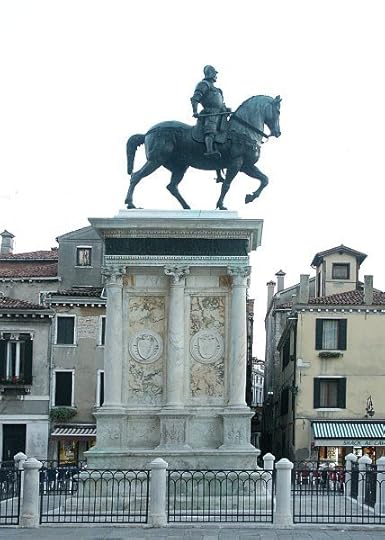
Andrea del Verrocchio, Equestrian Monument of Bartolommeo Colleoni,
Campo dei Santi Giovanni e Paolo. Bronze. 1483-1488
[image error]
David Hockney, Kaisarion with all his Beauty, 1961. Etching on paper.


“Untitled Anthropometry (ANT 100),” a 1960 work made by Yves Klein with “human brushes,” is part of the retrospective at the Hirshhorn Museum and Sculpture Garden in Washington.
By ROBERTA SMITH
Published: June 3, 2010
WASHINGTON — By now, hero worship of the French artist Yves Klein (1928-62) should be a thing of the past. Sure, he was charismatic, movie-star handsome and a black belt in judo, and he had a gift for provocative gestures. At the age of 19, on the beach with two friends, a poet and an artist, Klein “signed the sky” as his first work of art. In the mid-1950s he developed a smoldering ultramarine pigment that in a stroke of branding genius, he patented and named International Klein Blue.
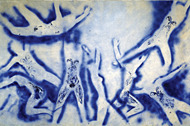
He also made all kinds of important art. His gloriously retinal blue monochromes are among the cornerstones of Minimalism; other works foreshadow Conceptual, performance, body and environmental art, not to mention the dematerialization of art. In an early version of commodity art, he sold collectors chunks of “invisible pictorial sensibility” (thin air) and then converted the purchase price into gold leaf that he frittered into the Seine while the buyer watched and a photographer took pictures.
He was the first artist to exhibit an art gallery as a work of art, in Paris in 1958. And in 1959 he lectured at the Sorbonne on “Art’s Evolution Toward the Immaterial.”
All this in a period of maturity that lasted slightly more than seven years.
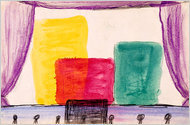
MORE.. http://www.nytimes.com/2010/06/04/art...
 German Artist Sigmar Polke Dies, Age 69, After Cancer Battle
German Artist Sigmar Polke Dies, Age 69, After Cancer Battle
June 11 (Bloomberg) -- Sigmar Polke, one of Germany’s best-known artists, died last night from cancer at the age of 69, his dealer Erhard Klein said in a phone interview.
Polke, a painter, graphic artist and photographer, was “one of the most important and most successful representatives of German contemporary art,” Culture Minister Bernd Neumann said in a statement. “He was a critical, ironic and self-ironic observer of postwar history and its artistic commentators.”
Born in 1941 in eastern Germany, Polke emigrated to the west in 1953. He settled in Dusseldorf, where he studied at the Art Academy. In 1963, he founded the “Capitalist Realism” painting movement with Gerhard Richter and Konrad Lueg. The three artists mocked both the realist style that was the official art of the Soviet Union and the consumer-driven pop art of the west. Polke moved to Cologne in 1978.
He experimented with a wide range of styles, subject matter and materials. In the 1970s, he concentrated on photography, returning to paint in the 1980s, when he produced abstract works created by chance through chemical reactions between paint and other products. In the last 20 years, he produced paintings focused on historical events and perceptions of them.
His work has been exhibited at London’s Royal Academy and Tate Modern, the Museum Ludwig in Cologne, the Martin-Gropius- Bau and Hamburger Bahnhof museums in Berlin, New York’s Museum of Modern Art, the Getty Museum in Los Angeles, the National Museum of Art in Osaka and the Guggenheim Museum in Bilbao, among others.
The record price for Polke’s work at auction was 2.7 million pounds (then $5.3 million) for a 1966 canvas titled “Strand” (Beach) that sold at Christie’s in London in 2007.
[image error]
Sigmar Polke
Strand
1966
£2,708,000
Christie’s London
Feb. 8, 2007
Vienna’s Museum of Modern Art and the Frieder Burda Museum in Baden-Baden held retrospectives in Polke’s honor in 2007.
“Polke’s death is a huge loss for the German and international art scene,” Burda said in a statement. His collection includes about 90 Polke works.
To contact the writer on the story: Catherine Hickley in Berlin at chickley@bloomberg.net.
[image error]
I Don’t Really Think About Anything Too Much
Courtesy Michael Werner, New York and Cologne © Sigmar Polke
[image error]
Fastest Gun in the West
Courtesy Michael Werner, New York and Cologne © Sigmar Polke
[image error]
Anyone Can Have Out-of-Body Experiences at Will
Courtesy Michael Werner, New York and Cologne © Sigmar Polke
[image error]
Triptych
Courtesy Michael Werner, New York and Cologne © Sigmar Polke
 More at the Morgan...
More at the Morgan...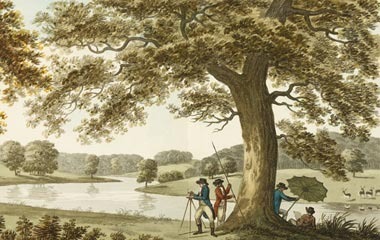
Romantic Gardens: Nature, Art, and Landscape Design
May 21 through August 29, 2010 http://www.themorgan.org/exhibitions/...
 Monica wrote: "Another exhibit at the Morgan I'd love to see...
Monica wrote: "Another exhibit at the Morgan I'd love to see...http://www.themorgan.org/exhibitions/..."
Me too!!
 I'm taking my dog and pony show on a road trip. Got skin care workshops scheduled in Staten Island and Westchester...putting feelers out anywhere between the Bronx and RI. Twist my arm and let's I'll have lunch at the Morgan! And the Met is only a cab ride away!
I'm taking my dog and pony show on a road trip. Got skin care workshops scheduled in Staten Island and Westchester...putting feelers out anywhere between the Bronx and RI. Twist my arm and let's I'll have lunch at the Morgan! And the Met is only a cab ride away!
 I'm not sure if it's art news exactly, but this item caught my eye. It's from the Modesto Bee:
I'm not sure if it's art news exactly, but this item caught my eye. It's from the Modesto Bee:Painter Thomas Kinkade arrested for alleged DUI
By Kim Minugh and Hudson Sangree

Famed Placerville-raised painter Thomas Kinkade has been arrested for allegedly driving drunk outside Carmel, according to the California Highway Patrol.
A Monterey County sheriff's deputy initially pulled over Kinkade's Mercedes Benz for a vehicle code violation Friday night, said CHP Officer Robert Lehman. After making contact with the 52-year-old Kinkade, the deputy suspected that he was drunk, Lehman said.
The deputy called the CHP to assist, and an officer performed tests to determine that Kinkade was impaired, Lehman said. The CHP officer arrested Kinkade just after 10 p.m., Lehman said.
Kinkade was booked into the Monterey County Jail on suspicion of misdemeanor drunken driving, Lehman said.
The arresting officer reported that Kinkade was "very polite" during the exchange, Lehman said.
Kinkade did submit to a blood test, Lehman said; however, the CHP is not releasing his blood-alcohol level.
Kinkade, dubbed the "Painter of Light," is the most-collected artist of modern times and likely the best-selling in history. Millions of his paintings are displayed in homes across the nation.
His specialties are light-filled scenes of cottages, lighthouses and chapels, and seaside and pastoral landscapes.
A nationwide network of art galleries specializes in his brand, and officially endorsed Web sites sell Kinkade-themed goods.
Kinkade was born in Sacramento and grew up in Placerville.
He graduated from the University of California, Berkeley, and the Art Center College of Design in Pasadena.
Read more: http://www.modbee.com/2010/06/14/1209...
 I'm not a fan of his artwork, but most of my friends at church love his work and have prints in their homes. It's sad when you see someone (who is successful & has the opportunities to help others) fall -- but we're all human.
I'm not a fan of his artwork, but most of my friends at church love his work and have prints in their homes. It's sad when you see someone (who is successful & has the opportunities to help others) fall -- but we're all human.
 Monica wrote: "Kinkade grew up in Placerville."
Monica wrote: "Kinkade grew up in Placerville."But how does that connet with Pleasantville? Am I being dense?
 Carol wrote: "I'm not a fan of his artwork, but most of my friends at church love his work and have prints in their homes. It's sad when you see someone (who is successful & has the opportunities to help others)..."
Carol wrote: "I'm not a fan of his artwork, but most of my friends at church love his work and have prints in their homes. It's sad when you see someone (who is successful & has the opportunities to help others)..."Kinkade's work is total crap. It's ridden with cliche and not even very competent.
He's a snake-oil salesmen of the first order. Somehow he's managed to convince a lot of gullible people that he alone has the secret of painting light.
That's hogwash. I taught that trick to students in their first semester. It's called "simultaneous contrast," and you figure it out in about 10 seconds using the color wheel.
He's also convinced those same gullible people, that a mechanical reproduction of a work of art, with a few dabs of real paint slapped on by assistants, is an original.
Even his so-called "prints" are not original prints, such as etchings, lithographs, silkscreens done by the artist, but mere mechanical reproductions.
Pfah on both his houses.
 Ruth wrote: "Pfah on both his houses..."
Ruth wrote: "Pfah on both his houses..."[image error]
Pinocchio Wishes Upon A Star by Thomas Kinkade
From Kincade's website: "For my painting Pinocchio Wishes Upon a Star we see Pinocchio upon a hillside overlooking the setting of his adventures. In the foreground we see Honest John, the symbol of temptation, and in the mid-distance we see Geppetto’s workshop where Pinocchio was formed. We see Stromboli’s puppet stage with the maestro himself holding court, and the seaport village in the distant where Pinocchio first learned of Pleasure Island. To the right we see Pleasure Island, aglow with the festivities of another day’s merriment and Monstro the whale preparing to engulf Geppetto’s sailing vessel. Butterflies and sparkles lend magical accents as the Blue Fairy and Jiminy Cricket look on. My prayer is that my Disney Dreams will make dreams come true for all who see these enchanted paintings."
 Jonathan wrote: "Ruth wrote: "Pfah on both his houses..."
Jonathan wrote: "Ruth wrote: "Pfah on both his houses..."Pinocchio Wishes Upon A Star by Thomas Kinkade
From Kincade's website: "For my painting Pinocchio Wishes Upon a Star we see Pinocchio upon a hillside ov..."
Gag.
 Maybe so. But I think that somewhere in there, between the image and Kinkade's description of it, there's room for a fascinating essay about 21st century taste, aesthetics, popular imagery, and the commerce of art.
Maybe so. But I think that somewhere in there, between the image and Kinkade's description of it, there's room for a fascinating essay about 21st century taste, aesthetics, popular imagery, and the commerce of art.I'm completely serious, by the way.
 So Disney studios agreed to allow him to paint their characters in his "Disney Dreams collection". And this is the 5th painting in the collection (previous ones -- Cinderella Wishes Upon A Dream, Tinker Bell And Peter Pan Fly To Neverland, Snow White Discovers the Cottage, and Bambi's First Year.)
So Disney studios agreed to allow him to paint their characters in his "Disney Dreams collection". And this is the 5th painting in the collection (previous ones -- Cinderella Wishes Upon A Dream, Tinker Bell And Peter Pan Fly To Neverland, Snow White Discovers the Cottage, and Bambi's First Year.)An unframed 24" x 36" Giclée is $1,360.00 plus $320 for frame
I would say that he is very talented at marketing.
And I'm disappointed that Disney would agree to this.
This is not art to me, this is all about making money.
 Jonathan wrote: "Maybe so. But I think that somewhere in there, between the image and Kinkade's description of it, there's room for a fascinating essay about 21st century taste, aesthetics, popular imagery, and the the commerce of art."
Jonathan wrote: "Maybe so. But I think that somewhere in there, between the image and Kinkade's description of it, there's room for a fascinating essay about 21st century taste, aesthetics, popular imagery, and the the commerce of art."Do you think that this is what most people think is "art"?
After touring & talking with the general public over many years, I really don't think so.
Can you imagine any art institution having one of Kinkade's Disney Dreams painting hanging on the wall?
Jonathan, are you going to write the essay?
 Jonathan wrote: "Maybe so. But I think that somewhere in there, between the image and Kinkade's description of it, there's room for a fascinating essay about 21st century taste, aesthetics, popular imagery, and the..."
Jonathan wrote: "Maybe so. But I think that somewhere in there, between the image and Kinkade's description of it, there's room for a fascinating essay about 21st century taste, aesthetics, popular imagery, and the..."You're absolutely right about that. But it doesn't make the art any less gagworthy.
 Carol wrote: "This is not art to me, this is all about making money..."
Carol wrote: "This is not art to me, this is all about making money..."That's a good point, Carol, and it would probably be the general argument of the essay I have in mind. But I think that I would want to frame the topic a little differently in this not-yet-written article and also bring in a few other issues, some of which we've already discussed here in the Art Lovers group.
Imagine this as the title: "Taste and Commerce: The Art of Jeff Koons and Thomas Kinkade."
The value of looking at these two figures together, to my mind, is that they do some very similar things--appropriation of commercial images, a wholehearted embrace of Kitsch, hyper-active self-promotion including extravagant claims about the "joy" they want to bring to the world, etc.--and yet each of them has a completely different "fan base." Most (although not all) of the people who praise Koons would tend to look down their noses at Kinkade, I think. And most who like Kinkade's art would tend to find Koons either troubling or ridiculous. Why is that?
Anyway, that's the idea I'm toying with.
 I guess the question is "What is art?" or "How do you define art?'
I guess the question is "What is art?" or "How do you define art?'I asked this question just the other day after viewing our new exhibit in the MATRIX contemporary art series called "Werewolf Karaoke" (MATRIX 159) by New York artist Justin Lowe.
The exhibit is 4 interconnected rooms that supposedly reference aspects of 2 period rooms in the museum (the Wetmore Parlor, and the Goodwin Reception Room) as well as the Austin House, designed by the art director at the time where the first floor is in the Baroque style and the second floor in the Bauhaus style. (Quite interesting just like the director.)
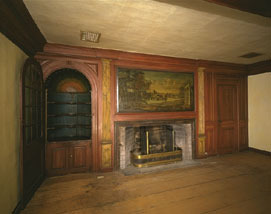
Wetmore Parlor, 1746-1765
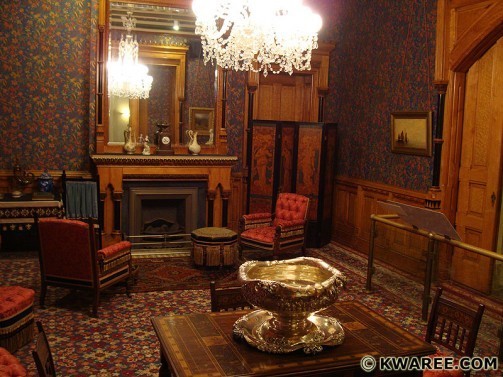
Goodwin Reception Room, 1874

Austin House, 1930


So in the contemporary exhibit these are what the 4 rooms are:
1. a gallery-- most interesting is the floor which looks like a rug but is really small paperback books tightly packed together on its spine so when you walk, you are on the edge of the pages and there is give to it. The walls have fun house mirrors.
2. a passageway (I think too small to be called a room or anything).
3. a video lounge (1970s psychedelia, video) there are big pillows lying on a black floor with black walls and black ceiling with 2 large screen TVs running with the people shooting up heroin.
4. a disgusting, dark, dirty public restroom, inspired by the
notorious graffiti-covered bathroom at CBGB, the legendary New York hardcore and punk rock club. Complete with dirty toilet, urinal and sinks.

This one has light.
Quote from the artist: “All of the imagery in the exhibition is in a state of dissolution. Hidden elements are revealed, but as they attain clarity they are once again obscured by an image emerging from beneath, similar to the classic werewolf transformation scene, which plays out metaphorically throughout the exhibition.”
I usually like contemporary art, but I didn't really think that this was "art."
 That would be a very interesting essay, Jonathan. I'd love to read it. It's a curious phenomenon, isn't it?
That would be a very interesting essay, Jonathan. I'd love to read it. It's a curious phenomenon, isn't it?
 Well, I guess I'll just have to write it, then...
Well, I guess I'll just have to write it, then...That Matrix exhibition at the Athenaeum looks interesting. A lot of installation art leaves me feeling, honestly, a little bit underwhelmed, but in this case the actual rooms of the Goodwin and Austin buildings look like they would be fun to explore and to contemplate, and the history of the Athenaeum as an institution seems quite fascinating.
 An addition on the back of my house with the Goodwin room installed and the cbgb walls + ceiling fine, but new plumbing would be a must!
An addition on the back of my house with the Goodwin room installed and the cbgb walls + ceiling fine, but new plumbing would be a must!Ruth my comment about Pleasantville/Placerville makes no sense. Kinkades paintings are so pleasant you would think he's from Pleasantville.
It's astonishing, Carol, you have friends who love Kincades work and even have his prints in their homes.
If I fo on a date and someone doesn't like the same music that's the end of that relationship. I don't think I could be friends with anyone who likes Kincade's artwork, well I have one friend who might like it but I'm not going to ask.
I like reading all your pieces, Johnathan.
Thanks for the Dutch landscape painting posts, too.
If you have some faves plz do tell.
 Monica wrote: "It's astonishing, Carol, you have friends who love Kincades work and even have his prints in their homes.
Monica wrote: "It's astonishing, Carol, you have friends who love Kincades work and even have his prints in their homes. I don't think I could be friends with anyone who likes Kincade's artwork . . . "
I think that my friends at church enjoy his work and feel that it has a Christian perspective which they want to display in their homes. As a Christian, I am very happy to be apart of the congregation & this church, the people are great even though we differ with regards to art and I'm sure in other things. As long as they're genuine, I think it's great to have friends who have different interests. Otherwise how could I grow as a person?
 Jonathan wrote: "Well, I guess I'll just have to write it, then... the actual rooms of the Goodwin and Austin buildings look like they would be fun to explore and to contemplate, and the history of the Athenaeum as an institution seems quite fascinating. "
Jonathan wrote: "Well, I guess I'll just have to write it, then... the actual rooms of the Goodwin and Austin buildings look like they would be fun to explore and to contemplate, and the history of the Athenaeum as an institution seems quite fascinating. "Here's a few books you could check out-

Magic Facade: The Austin House, by Eugene Gaddis
http://www.powells.com/biblio/9780918...

Magician of the Modern: Chick Austin and the Transformation of the Arts in America
by Eugene R. Gaddis
http://www.powells.com/biblio/1-97803...
I loved this book, I didn't want it to end. As Virgil Thomson's stated, "Chick Austin was a whole cultural movement in one man."
Gene is great --
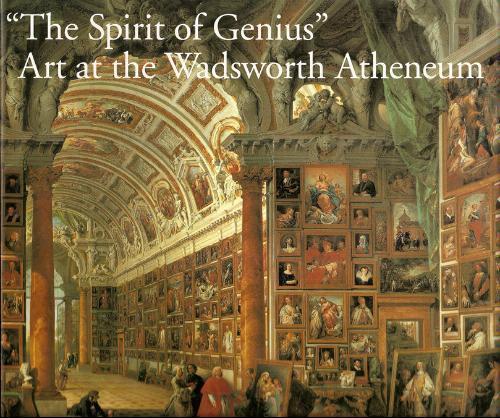
The "Spirit of Genius": Art at the Wadsworth Atheneum
Linda Ayres (Editor)
But this only has one page of info on each room and a photo on the second page. I could check our docent files to see if there is any other publication or info. if you want. I'm doing a tour on this upcoming Sunday.
 Monica wrote: "Ruth my comment about Pleasantville/Placerville makes no se..."
Monica wrote: "Ruth my comment about Pleasantville/Placerville makes no se..."And here I was sure that it had some deep connotation that I just wasn't getting.
My dear cousin, who is the closest thing I have to a sister, has a Kinkade. I haven't been to her new house, but I hope she hasn't hung it next the drawing of mine she has!
 Thanks for all the info, Carol.
Thanks for all the info, Carol. I think I should probably fess up that I had lunch with Elizabeth Kornhauser this afternoon, here in New York, to talk about that upcoming show of 20th-century American works on paper and about the Wadsworth Athenaeum in general. So basically, I'm almost certain to write about the museum this autumn or winter, although I'm not yet sure from what angle I'll approach the subject.
She too recommended the book on Chick Austin, "Magician of the Modern," and said that it was both supremely intelligent and a great joy to read. I've just ordered a used copy through Abebooks and should have it next week.
With regard to what you say about members of your church liking Kinkade's Christian art, that seems like an entirely valid reason for appreciating some of his works, and personally I wouldn't argue with it.
I stacked the deck against Kinkade a bit by posting the Pinocchio picture, which is the most egregious one I could find on his site. Going back to the site now and looking at the Christian-themed pictures, I have to say I'm not wild about the more mystical pieces--like "Cross on a Hillside," which I think is overly theatrical and doesn't really relate to the way that I personally experience the Bible or my Christian faith--but this much simpler image (below) of a chapel in the countryside is, I think, a fairly effective evocation of a well-respected theme in spiritually-conscious landscape painting: the well-made universe where each of us has a place and the Lord's handiwork is palpable in the vivid sky.
Van Gogh, when he first started to paint, did many pictures with similar motifs and a similar attitude, by the way. (As you probably know, Van Gogh's father and grandfather were Dutch Reformed ministers.) And I think that you can find a similar underlying theme, expressed somewhat more subtly, in a lot of (though not all) 16th and 17th-century Dutch and Flemish landscapes, too, although that's probably a topic for another time.
In any case, the Kinkade version isn't necessarily a picture I love, but I can certainly grasp what it's about and can understand why some people might love it. The Pinocchio picture, however, I really don't understand at all...

Sunrise Chapel by Thomas Kinkade
"Thy mercies are new every morning" - Lamentations 3:23
 It is. And, as I said, it's not for me as an object of aesthetic delight. But I can certainly see it being part of the decor in many people's homes, particularly if the owners felt that the image connected them, as Carol mentioned with regard to her neighbors, to a sense of their faith.
It is. And, as I said, it's not for me as an object of aesthetic delight. But I can certainly see it being part of the decor in many people's homes, particularly if the owners felt that the image connected them, as Carol mentioned with regard to her neighbors, to a sense of their faith.People have a variety of ways of expressing that kind of connection. My grandmother has a crucifix over her bed. I know people who have devotional images of Jesus around the house.
I don't happen to have any of those things, but when my wife and I got married, her aunt, who is very devout, gave us a framed, hand-written, calligraphic prayer that blessed our house in the name of the Father, the Son, and the Holy Spirit, and then went on to beseech the Trinty's intercession in protecting us from the Evil One.
It's not necessarily the sort of thing that we would have gotten for ourselves, but we hung it up in the kitchen. We had it on the wall for a long time, until we moved a few years ago, and now I honestly don't know where it is.
But anyway, I didn't have it there because I thought it was art. On some level, I felt obligated to hang it because it seemed polite to my wife's aunt to do so; and on another level, I guess a little protection from the "Evil One" didn't seem to me like such a bad thing to have. You can never be too careful...
 I guess I'm with Monica on this. Where I live now I am surrounded by people who like what I would call elevator music. One told me recently she never attended the opera because she couldn't afford it. But I used to go standing at $5 a pop. So opera (and symphony) doesn't have to be a matter of money, but of taste. It isn't that I dislike the people I associate with here, but they have entirely different taste in most things than I have. And it is such pedestrian taste, that I don't find the difference stimulating.
I guess I'm with Monica on this. Where I live now I am surrounded by people who like what I would call elevator music. One told me recently she never attended the opera because she couldn't afford it. But I used to go standing at $5 a pop. So opera (and symphony) doesn't have to be a matter of money, but of taste. It isn't that I dislike the people I associate with here, but they have entirely different taste in most things than I have. And it is such pedestrian taste, that I don't find the difference stimulating.Carol wrote: "Monica wrote: "It's astonishing, Carol, you have friends who love Kincades work and even have his prints in their homes.
I don't think I could be friends with anyone who likes Kincade's artwork ...."
 Jonathan wrote: "But anyway, I didn't have it there because I thought it was art."
Jonathan wrote: "But anyway, I didn't have it there because I thought it was art."That's the key difference, don't you think? Kinkade's fans think his drek is wonderful, significant art.
 Ruth wrote: "Jonathan wrote: "But anyway, I didn't have it there because I thought it was art."
Ruth wrote: "Jonathan wrote: "But anyway, I didn't have it there because I thought it was art."That's the key difference, don't you think? Kinkade's fans think his drek is wonderful, significant art."
That's a good point. I'm honestly not sure what his fans think, but if I plan to do an article at some point, I should probably locate a few Kinkade fans and listen to what they say. I could also do the same thing for fans of Koons and then compare...
 Jonathan wrote: "Thanks for all the info, Carol.
Jonathan wrote: "Thanks for all the info, Carol. I think I should probably fess up that I had lunch with Elizabeth Kornhauser this afternoon, here in New York, to talk about that upcoming show of 20th-century Ame..."
As I understand it, the show is currently traveling and is in Portland Maine. Betsy is great – usually the curators do our training.
I'm so glad that you are going to read "Magician of the Modern" - it's a great read. The way Gene writes, you come to love this innovative man -- Chick Austin. We were so fortunate to have him as our director.
Regarding Kinkade, I really don't care for any of his work. I don't find anything spiritual in it.
Personally, while I appreciate & marvel at the artwork of paintings of saints, and of scenes of Christ’s life, none of them have a day-to-day meaning for me in my Christian life. The Protestant Reformation made landscapes and still life painting a new way for Christians to have a day-to-day relationship with God. I think it was a return to biblical truth.
And I can relate to receiving a "christian" gift and putting it up out of respect to the family member who gave it. My aunt gave us this huge Pennsylvania Hex sign to put on the outside of our home. We put it up but it's on the side of the house, near our front door on the porch. It's definitely not our "style" but it makes her feel good and it doesn't hurt to have our home blessed.
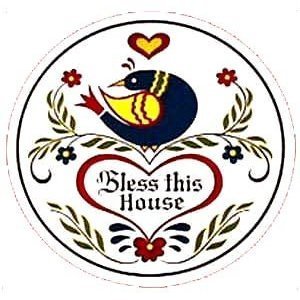
 Researchers Identify Bones as Caravaggio’s
Researchers Identify Bones as Caravaggio’sBy FELICIA R. LEE,
New York Times, June 16, 2010
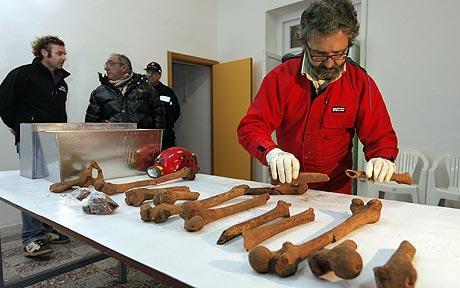
A geologist organizes bones presumed to belong to Caravaggio Photo: AFP/GETTY
The remains of Caravaggio, the celebrated Baroque artist, have almost certainly been found in a Tuscan ossuary, lifting a centuries-old mystery over his burial, Reuters reported. Researchers for Italy’s National Committee for Historical, Cultural and Environmental Heritage said on Wednesday that they were confident that the bones found in the ossuary matched those of Michelangelo Merisi, the artist known as Caravaggio.
“We have carried out DNA testing on these remains and looked at the results alongside presumed relatives of Caravaggio, people with the same family name,” Giorgio Gruppioni, a physical anthropologist, told Reuters television. “We have compatibility with these genetic strands.”
Theories about the artist’s death have had him succumbing to syphilis or being murdered. Caravaggio, who was 38 when he died on a beach north of Rome in 1610, pioneered chiaroscuro, the painting technique of contrasting light and dark. He was also known as a rogue given to brawls, chasing men and women, and even murdering a tennis opponent.
 Carol wrote: "The Protestant Reformation made landscapes and still life painting a new way for Christians to have a day-to-day relationship with God. I think it was a return to biblical truth. ..."
Carol wrote: "The Protestant Reformation made landscapes and still life painting a new way for Christians to have a day-to-day relationship with God. I think it was a return to biblical truth. ..."This is a very interesting point, Carol, and I'm going to link from here to the discussion thread for June's favorite pictures, where we were talking about 17th-century Dutch landscapes because I think you've really hit on something important.
Although the genres of still life and landscape trace their origins to a period prior to the Reformation, they were initially confined, in general, to motifs incorporated into larger compositions. The objects arrayed on the table in a Last Supper, for instance, could be said to form a still life. And the mysterious, cloudy hillside in Leonardo's "Virgin of the Rocks" is a type of landscape.
But it's important to note that even as free-standing genres, still-life and landscape began to come into their own at first in pre-Reformation Catholic Europe, not Protestant Europe.
Here for instance is an early Memling still life from 1480--or about three years before Martin Luther's birth:
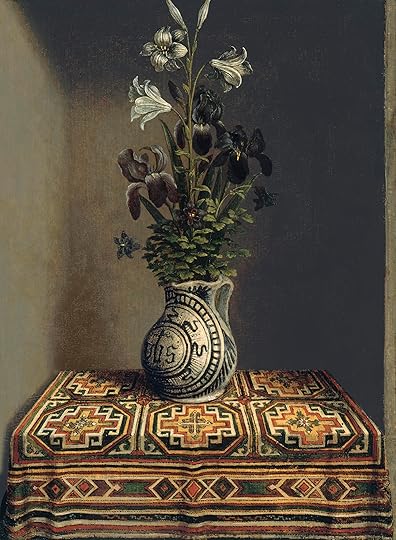
On a somewhat more earthy note, the moody foreboding of 17th-century bodegones, or Spanish pantry still-lifes, has often been interpreted as a Catholic meditation on the evanescence of earthly existence. Here is an example by Francisco de Zurbarán, who along with Juan Sánchez Cotán and Juan van der Hamen, was among the great masters of the genre--and with this image in particular, which shows a slaughtered lamb with all the Christian symbolic importance that attaches thereto, it's important to remember that "still life" translates into Spanish as naturaleza muerta, which, like the French nature morte, literally means "dead nature":
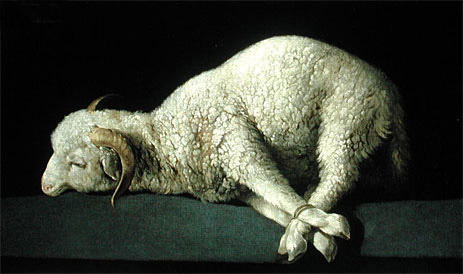
Francisco de Zurbarán, The Sacrifice (1632)
Likewise, landscape began to emerge as a genre in mediaeval calendars and books of hours, usually in suites or groupings representing the four seasons or the twelve months of the year and accompanied by Bible verses meant to underscore the cycle of life in a Christian context. Here, the image for February from the Très Riches Heures du Duc de Berry:
[image error]
The Christian religious context becomes somewhat subtler as landscapes make the transition into panel painting. Here, in another winter scene, "The Hunters in the Snow," a work by Pieter Brueghel the Elder, who lived in Spanish-controlled (Catholic) Flanders, one sees only rather cryptic references to the themes of mortality and earthly transience: birds, traditionally understood to symbolize the soul or spirit, are the hunters' prey:

And so, what happens to landscapes and still lifes after the Reformation--and what makes the northern Dutch (Protestant) tradition different from the southern Dutch (Catholic) tradition, as typified by Brueghel? Take a look at this image below, yet another winter scene, by Hendrick Avercamp, a 17th-century Dutch artist who specialized in pictures set amid snow and ice:
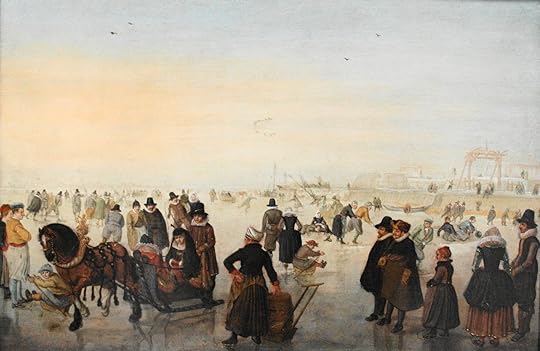
Avercamp deviates sharply from the southern Netherlandish tradition by displaying scarcely any trace of spiritual unease in his work, which consists, by and large, of a closely observed celebration of the habits and customs of the community, not a meditation on the end of days. Working just one generation after Brueghel, Avercamp adopts the older artist’s pale backgrounds and bright local coloring, but Brueghel’s gravitas gives way to what the Dutch might call gezelligheid, a term sometimes translated as "coziness," although it also implies numerous other qualities, such as charm, festivity, and a broad sense of good fellowship.
Looking at Avercamp’s work, one surmises--perhaps erroneously--that winter was a very gezellig time of year during the 17th century, that men and women, young and old, rich and poor, all took gamely to the ice in order to skate, sled, fish, play "colf" (a precursor to hockey), toss snowballs, or simply enjoy the company of neighbors. Although Avercamp’s subject is, in essence, sheer joy, he manages to avoid insipidness not only through his craftsmanship and attention to telling details but through his ability to capture an evolving and important aspect of his society’s underlying ethos: from a nationalistic standpoint, the very contentment of the Dutch could be taken as a manifestation of their rectitude--their state of predestined Calvinist grace--and their right to stand independent from the oppressive designs of outside powers, namely Catholic Spain, with which the Netherlands remained locked in an ongoing battle for independence.
This notion of "pride of place" as a form of political and religious nationalism is one that comes up frequently in discussions of 17th-century Dutch cityscapes, such as this beautiful image by Jan van der Heyden of a street along an Amsterdam canal:
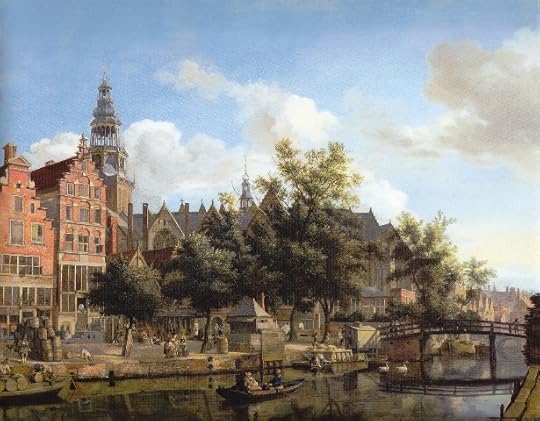
I discuss this idea at greater length in an essay that I wrote on Dutch cityscapes for the UK art magazine Apollo, which you can read here, if you're interested: http://www.jonathanlopez.net/Cityscap...
And I go into Avercamp and the evolution of the European winter landscape in another Apollo essay that you can find here: http://www.jonathanlopez.net/Avercamp...


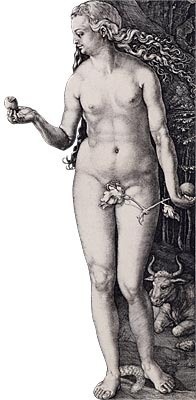 Another exhibit at the Morgan I'd love to see...
Another exhibit at the Morgan I'd love to see...

In this Oct. 3, 2007 file photo, French-born artist Louise Bourgeois' sculpture of a giant spider, "Maman" 1999, stands outside the Tate Modern in London. The sculpture, one of a series of six, is more than nine metres high and made of bronze, stainless steel and marble. Her studio's managing director says artist Louise Bourgeois died in New York City, after a lengthy career of exploring women's deepest feelings on birth, sexuality and death. She was 98. Wendy Williams of Louise Bourgeois Studio says the sculptor died at Beth Israel Medical Center on Monday, May 31, 2010 two days after suffering a heart attack. AP Photo/Nathan Strange.
By: Jennifer Peltz, Associated Press Writer
NEW YORK, NY (AP).- Artist Louise Bourgeois, whose sculptures exploring women's deepest feelings on birth, sexuality and death were highly influential on younger artists, died Monday, her studio's managing director said. She was 98. Bourgeois had continued creating artwork — her latest pieces were finished just last week — before suffering a heart attack Saturday night, said the studio director, Wendy Williams. The artist died at Beth Israel Medical Center in Manhattan, where she lived. Working in a wide variety of materials, she tackled themes relating to male and female bodies and emotions of anger, betrayal, even murder. Her work reflected influences of surrealism, primitivism and the early modernist sculptors such as Alberto Giacometti and Constantin Brancusi. "I really want to worry people, to bother people," she told The Washington Post in 1984. "They say they are bothered by the double genitalia in my new work. Well, I have been bothered by it my whole life. I ... More http://www.artdaily.com/index.asp?int...
A file picture dated 04 March 2008 shows the bronze sculpture 'Arch of Hysteria' (1993) by French-born US artist and sculptor Louise Bourgeois on display at the Centre Pompidou in Paris, France. Louise Bourgeois, 98, died of a heart attack on 31 May 2010, in New York City, New York, USA. EPA/HORACIO VILLALOBOS.